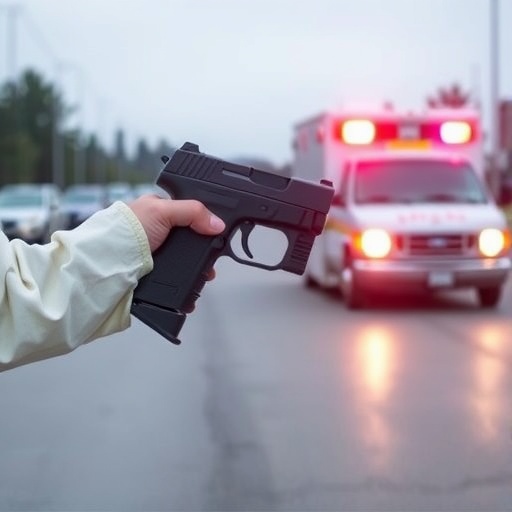In a groundbreaking study presented at the American Academy of Pediatrics 2025 National Conference & Exhibition in Denver, researchers uncovered a concerning connection between different types of trauma faced by children and youth. In a striking revelation, they reported that nearly one in four patients treated in emergency departments for firearm-related injuries had previous visits related to injuries sustained from motor vehicle crashes or other forms of violence. This alarming statistic not only highlights the recurring nature of trauma in these young patients but also suggests a pattern of risky behaviors that could be mitigated through targeted interventions.
The research, entitled “Associational Analysis for Pediatric Firearm Injury Risk,” examined emergency department records from over 2,600 visits spanning four years, from 2018 to 2022, at a pediatric health system in the Midwest. The study’s authors, led by Dr. Mike Levas, a senior physician and professor at the Medical College of Wisconsin, posited that the significant association between firearm injuries and prior injuries suggests that these traumatic events do not occur in isolation. Instead, they form part of a troubling continuum that calls for urgent attention from medical professionals, policymakers, and community leaders alike.
Dr. Levas articulated the implications of these findings, stating that the data indicates nearly 25% of children who suffer firearm injuries are likely to return to emergency care due to another violent incident or a motor vehicle crash within a short time frame. This statistic emphasizes an interconnectedness of risks; each incident may propel the next, creating an escalating cycle of risk that could lead to catastrophic outcomes. For healthcare providers, recognizing this pattern presents an opportunity for early intervention efforts aimed at curtailing the trajectory of repeated injuries.
In particular, the study draws attention to the prediction of subsequent firearm injuries based on earlier encounters with non-firearm violence or car accidents. Findings indicated that the type and severity of these injuries could serve as strong indicators of whether a child might face a repeat encounter involving firearms. Analysis revealed that children who experienced high-severity injuries from motor vehicle crashes were more likely to be victimized by firearm-related incidents in the future. This predictive modeling indicates a significant correlation that could inform clinical practices and public health interventions targeting youth at higher risk.
Maria Beyer, a co-author of the study and community health evaluation manager, advocated for a collaborative approach in addressing the complex dynamics of injury patterns. She emphasized the necessity for partnerships among community health teams, medical professionals, and researchers to devise evidence-based strategies that effectively address and prevent these injuries. The combined expertise from both clinical insights and community dynamics can yield a holistic understanding of the unique challenges faced by at-risk youth, facilitating targeted interventions aimed at breaking the cycle of violence and injury.
The authors of the study unveiled that their methods included comprehensive statistical analyses, such as chi-square tests for independence and logistic regression modeling, which revealed pivotal insights into demographic predictors and injury severity correlations. As they worked through the data, the research demonstrated not just statistical significance but notable implications for clinical strategies. The acknowledgment that children returning from violent injuries could be at greater risk for future firearm injuries equips healthcare providers with critical information necessary for implementing preventive measures.
Moreover, the findings highlight the need for integrating clinical practices with community-based interventions focused on kids confronted with trauma. A deeper understanding of the experience of these children can massively change the landscape in which health systems operate. By harnessing data and observations from medical histories and family dynamics, clinicians can prioritize interventions that are tailored to the needs of the community, thereby promoting safety and well-being.
Given the clear association identified, the study advocates for early interventions designed to reduce risks associated with firearm injuries in pediatric populations. Crosstalk between healthcare practices and community support systems stands to enhance the efficacy of preventive strategies developed. As Beyer posits, observant healthcare teams can relay critical observations of injury patterns and community health teams can mobilize resources and support systems to mitigate risks effectively.
Furthermore, the alarming rise in pediatric injuries relates to firearms and motor vehicle crashes compels a discussion surrounding public health policies. The convergence of these two health concerns underscores a pressing need for multi-faceted, community-oriented solutions. Policymakers must engage with research findings that illuminate the shared risk factors contributing to this violence, allowing for an aligned framework that incorporates safety measures in vehicle-related violence and gun law reform.
As the study progresses from presentation to potential publication, the emotional and physical toll of recurrent trauma on children serves as urgency to address these intertwined issues. A call to action emerges for further investigations aimed at refining early intervention strategies while applying robust resources to minimize pediatric firearm injuries. The need for effective treatment protocols and community outreach initiatives is strikingly clear, emphasizing the role of healthcare professionals as advocates in bridging gaps between clinical care and social determinants of health.
In summary, this compelling research offers critical insights into the connection between types of injuries experienced by youth in emergency departments. The emphasis placed on predictive modeling presents a multifaceted approach to addressing the complexities of trauma, demonstrating that healthcare settings have the capability to influence outcomes by adopting proactive stances in patient care. As the collaboration between health professionals and community stakeholders intensifies, they stand poised to impact profoundly the course of injuries associated with firearms and vehicular incidents in children and adolescents.
The hope is that with dedicated efforts and sustained engagement, a new paradigm of preventive care may emerge—one in which children don’t merely survive their injuries, but are equipped with the tools and support systems to thrive in safer environments, ultimately breaking the cycle of violence and fostering healthier futures for generations to come.
Subject of Research:
Article Title: Research Shows Significant Association Between Emergency Department Visits for Firearm and Motor Vehicle-Related Crashes
News Publication Date: 26-Sep-2025
Web References:
References:
Image Credits:




